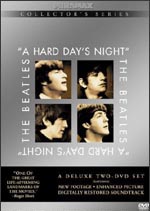
HARD DAY’S NIGHT, A
Reviewed October 7th, 2002 by Brian White
Nobody has been bigger than the Beatles. No media frenzy has ever been bigger. No entertainment event has commanded the attention of as many people as Beatlemania. That alone makes A Hard Day’s Night relevant. It was made in the middle of the hurricane.
Upon their return to England, after the ridiculously successful promotional tour of North America, the Beatles began work on their first feature film. It is difficult to separate the Beatles’ situation from the way that the media treats modern pop phenomena. While not on the Beatles’ level, it is hard to imagine N’Sync or Britney Spears making the sort of movie that the Beatles did. The Fabs went out of their way to avoid the type of flick that pop stars traditionally made. I don’t think one of today’s pop stars could make a movie with an experimental director.
Richard Lester, an ex-patriot American, was directing British television… well, no he was revolutionizing television in general without knowing it. Lester directed the Goon Show. Peter Sellers and Spike Milligan starred in this zany show that the Beatles, and most of England loved. It was also an inspiration to Monty Python. Anyway, Lester’s stuff, though popular, was pretty weird. He was brought in to direct the flick, and was given lots of freedom.
Apart from being a Beatles movie, Hard Days Night is given respect in terms of its cinematic worth. Lester’s style is said by some to be an evolution of the hand-held “new wave” style of French cinema in the fifties. The original Breathless falls into this category.
A Hard Day’s Night follows the Beatles through a fictional day in their life. Everything is crazy, and the lads are suitably charming.
The movie can be plenty weird. Hard Days Night is pre-psychedelia, so it’s not that kind of weird. Instead, you get situations that seem like inside jokes, with a hint of the surreal. It is also filled with references that would have made much more sense in early-sixties Britain. For example, Wilfrid Brambell’s character is constantly being called “very clean.” This is a tongue in cheek reference to a catch phrase on his television show where he was constantly being referred to as a “dirty old man.” Only the British audience of the day would have understood this. The script, for which Alun Owen was nominated for an Oscar, is very clever in places. Just listen to the dialog when George mistakenly walks in on the professional trendsetters. The movie was very successful in the United States, so despite being a different kind of film, or possibly because people focused on the Beatles, the audience somehow got it.
This movie has always looked bad during my lifetime. No more. I cannot believe that a print this clean was found. While it isn’t perfect, it is very surprising. The aspect ratio is 1.66:1, and the transfer is anamorphic.
For audio, they’ve cleaned things up there too. There is a Dolby Digital 5.1 mix on the disc, but it is mostly toward the front, unlike the dynamic Yellow Submarine mix. Also unlike the Yellow Submarine mix, the original mixing of the songs seems to be maintained. Basically the new mix fills out the sound, rather that screwing up where you’re used to hearing the songs come from. Also, dialog is much easier to understand in this mix.
Extras? There’s a whole lot here, but it still feels wanting. Obviously, an effort was made to make this the definitive edition of the film; but we could have gotten so much more. The biggest complaint is that this disc is completely uninfested by Beatles. There are no recollections from the surviving mop-tops, and that’s a shame. I guess you have to pay up for the coffee table book to get their recollections. There is a great documentary on the first disc, detailing the genesis, production and aftermath of the film. The second disc contains a series of interviews with people involved in the production. You don’t get a commentary by Lester, but he spouts plenty of info about the production in the interviews. We get a glimpse at the Lester film, The Running, Jumping and Standing Still, that is said to be the inspiration for the film, but the entire short isn’t here, as it was in the previous DVD issue of the film. Some of the included interviews are worthwhile, some are not. It’s a mixed bag.
There are nuggets of info here and there, but this purchase is all about the picture and the sound.
Please help support our site by buying this DVD title
through this link. Thank you
kindly.
|


 Purchase
This DVD Purchase
This DVD
 Purchase Promo Poster Purchase Promo Poster
Story / Content

Audio

Video

Extras

|